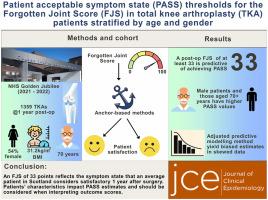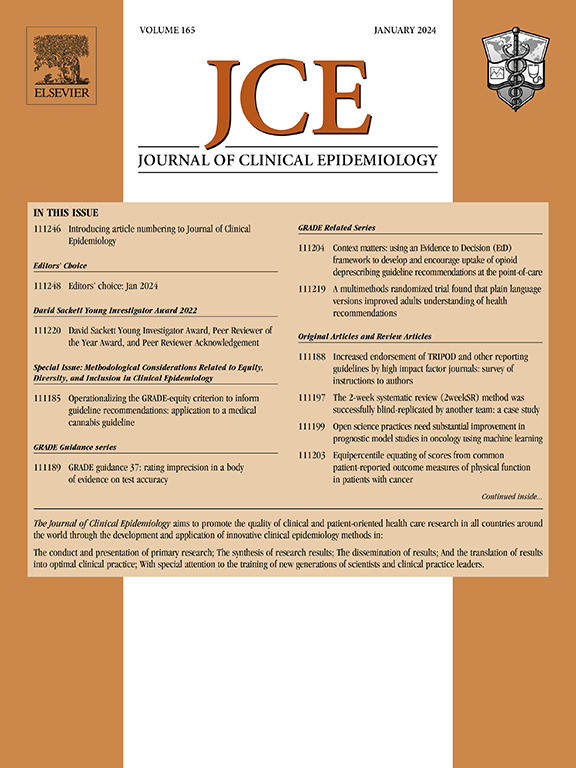Anchor-based predictive modeling and receiver operating characteristic curve estimates of patient acceptable symptom state for the forgotten joint score in total knee arthroplasty patients stratified by age and gender
IF 5.2
2区 医学
Q1 HEALTH CARE SCIENCES & SERVICES
引用次数: 0
Abstract
Objectives
This study aimed to estimate patient acceptable symptom state (PASS) thresholds in the Forgotten Joint Score (FJS) 1 year following primary total knee arthroplasty (PTKA) while investigating the impact of patients’ characteristics on PASS thresholds.
Study Design and Setting
This cohort study used data from patients who underwent PTKA at a public hospital in Scotland between April 2021 and December 2022. Assessment of FJS (0-100, high-low knee awareness) was completed 1 year postoperatively. A single-item question about satisfaction with the operated knee was completed at 1 year and served as the anchor for estimating PASS thresholds. Anchor-based predictive modeling (adjusted and unadjusted) and receiver operating characteristic (ROC) curve methods were used to determine PASS thresholds. The impact of patient characteristics on PASS threshold values was investigated by calculating stratified PASS values based on gender and age groups.
Results
A total of 1832 PTKAs were performed between April 2021 and December 2022, of which 1359 (74%) had complete data comprising the study cohort. The median age and body mass index of patients included in the study were 70 years and 31.2 , respectively, with 54% being females. The proportion of satisfied patients was 84%. A moderate positive correlation between FJS and patient satisfaction was found (r = 0.64, P < .001), which supports the validity of the external anchor. PASS thresholds for the entire cohort were 31 (ROC method) and ∼33 points (predictive modeling method). Larger PASS values were found for male patients and patients aged ≥70 years compared to their female and younger counterparts. The adjusted predictive modeling estimate was 15.3; given that the data do not meet the assumption of normal distribution, we consider this threshold might be biased and must be interpreted with circumspection.
Conclusion
A postoperative FJS of ≥33 points can be used as a reference guide to evaluate successful achievement of a “forgotten joint” in a Scottish population. Patients’ characteristics impact PASS estimates and should be considered when interpreting outcome scores.
Plain Language Summary
After knee replacement surgery, patients want their new knee to feel natural. The FJS measures how much a person notices their artificial knee in daily life. The score goes from 0 to 100, with higher numbers meaning the knee feels more natural. We studied data from over 1300 patients in Scotland using modern statistical methods. Our results show that most patients need a score of at least 33 to feel satisfied with their knee 1 year after surgery, while men and people aged ≥70 years seem to need higher scores.

基于锚定的预测模型和受试者操作曲线估计全膝关节置换术患者可接受的遗忘关节评分症状状态。
目的:评估首次全膝关节置换术(PTKA)后1年遗忘关节评分(FJS)中患者可接受症状状态(PASS)阈值,同时研究患者特征对PASS阈值的影响。研究设计和环境:本队列研究使用了2021年4月至2022年12月在苏格兰一家公立医院接受PTKA的患者的数据。术后1年完成FJS评分(0-100分,高低膝关节意识)。一个关于手术膝关节满意度的单项问题在一年内完成,并作为估计PASS阈值的锚点。采用锚定预测模型(调整和未调整)和受试者工作特征(ROC)曲线方法确定PASS阈值。通过计算基于性别和年龄组的分层PASS值,研究患者特征对PASS阈值的影响。结果:在2021年4月至2022年12月期间,共进行了1832例ptka,其中1359/1832例(74%)具有完整的研究队列数据。纳入研究的患者中位年龄和BMI为70岁,31.2 kg/m2,其中54%为女性。满意患者比例为84%。FJS与患者满意度之间存在中度正相关(r = 0.64, P < 0.001),支持外锚的有效性。整个队列的合格阈值为31点(ROC法)和~ 33点(预测建模法)。与女性和年轻患者相比,男性患者和70岁以上患者的PASS值较大。调整后的预测模型估计值为15.3,考虑到数据不符合正态分布的假设,我们认为这个阈值可能是有偏差的,必须谨慎解释。结论:在苏格兰人群中,术后FJS≥33分可作为评估“遗忘关节”成功实现的参考指南。患者的特征影响PASS的估计,在解释结果评分时应考虑到这一点。
本文章由计算机程序翻译,如有差异,请以英文原文为准。
求助全文
约1分钟内获得全文
求助全文
来源期刊

Journal of Clinical Epidemiology
医学-公共卫生、环境卫生与职业卫生
CiteScore
12.00
自引率
6.90%
发文量
320
审稿时长
44 days
期刊介绍:
The Journal of Clinical Epidemiology strives to enhance the quality of clinical and patient-oriented healthcare research by advancing and applying innovative methods in conducting, presenting, synthesizing, disseminating, and translating research results into optimal clinical practice. Special emphasis is placed on training new generations of scientists and clinical practice leaders.
 求助内容:
求助内容: 应助结果提醒方式:
应助结果提醒方式:


